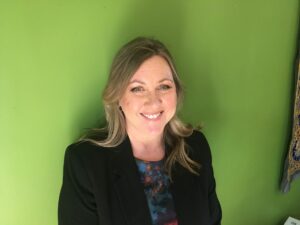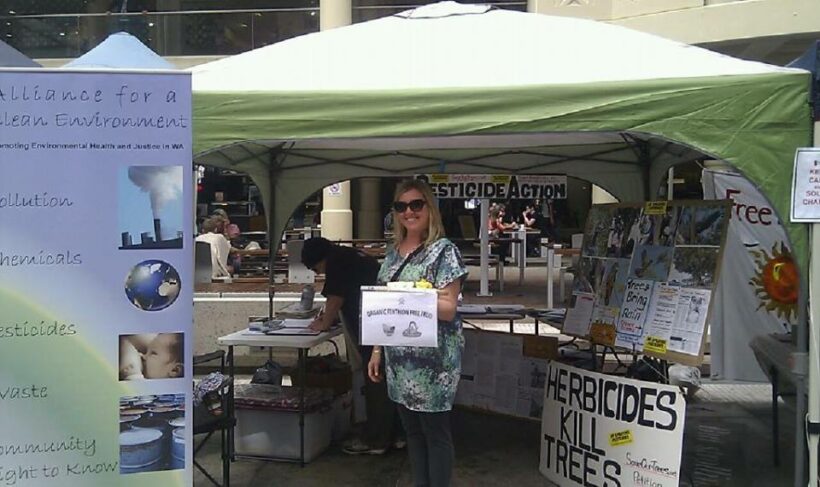Jane Bremmer: At the forefront of environmental justice
by Johanna Poblete
 When Jane Bremmer and her partner Lee bought a weatherboard cottage in the outer suburban area of Perth called Bellevue, they had plans to build a ceramics business from home. This was the ’90s, and the young couple was the proud owners of a backyard filled with fruit trees that seemed an idyllic play space for their four-month-old son, and an outdoor shed that could serve as their ceramics workshop. However, their dream died the day Lee dug a hole in the backyard and suffered acid burns to his arms due to soil and water contamination from a nearby toxic waste dump.
When Jane Bremmer and her partner Lee bought a weatherboard cottage in the outer suburban area of Perth called Bellevue, they had plans to build a ceramics business from home. This was the ’90s, and the young couple was the proud owners of a backyard filled with fruit trees that seemed an idyllic play space for their four-month-old son, and an outdoor shed that could serve as their ceramics workshop. However, their dream died the day Lee dug a hole in the backyard and suffered acid burns to his arms due to soil and water contamination from a nearby toxic waste dump.
“Unbeknownst to us, we had just bought a house next door to Western Australia’s worst toxic site. An American waste oil company [Omex Petroleum] had been operating across the road and had, for 50 years, been dumping their waste oil in a clayhole in the ground. It had regularly caught fire, it regularly overflowed, the whole community had been contaminated for years, but no one talked about it,” Jane said.
Becoming a voice for the voiceless
An environmental crusader since her university days who has campaigned for nuclear, peace and disarmament and for protecting forests and oceans before climate change became a byword, Jane co-founded the Bellevue Action Group (BAG), together with her partner and their neighbors following her firsthand experience of the impacts of toxic waste dumping in her own backyard.
The group had no problems with recruitment, particularly among mothers. “Most petrochemical-based pollution contains endocrine-disruptive chemicals, which is the type of pollution that impacts women and children disproportionately because of their physiology. Women and children are more likely to be exposed to contamination in their homes and gardens. I started to hear the stories about the women and the kids that were sick — the unexplained illnesses. So it was women talking to women,” Jane said.
The BAG became a platform for sharing experiences — to validate the truth about the situation and make it available for other people, particularly authorities, to hear and highlight the problems that needed to be addressed. It became a mouthpiece for the residents who were unable to speak out.
“There are many reasons people don’t speak out in our community: for cultural, religious or social reasons including fear of retribution, [because of] their histories. We understood that there were a lot of Polish immigrants that did not want to be identified, but they still had relevant information to contribute and were entitled to environmental justice. So that was a platform to help represent those communities,” Jane said.
The group effectively lobbied for the government to have the contaminated clayhole capped, the toxic vapors extracted, the most affected residents relocated, and the dumpsite remediated—but not without costs to themselves. Residents were subjected to bullying and intimidation. They also suffered from ill health and personal financial loss. They could not in good conscience offload their devalued property onto unsuspecting buyers. After seeking legal counsel that resulted in zero compensation, Jane and her family abandoned their home rather than prolong their exposure to health hazards.
Forming alliances for collective action
The BAG attracted the attention of communities in similar situations. Banding together, they formed the statewide Contaminated Sites Alliance (CSA), which dedicated itself to educating the broader community about the risks associated with contaminated sites. They pursued legal groundwork for transparency on the location and management of these sites and played a crucial role in the passage of the unprecedented Contaminated Sites Act, under which “known or suspected contaminated sites must be reported to the Department of Water and Environmental Regulation (DEWR), investigated and, if necessary, cleaned up (remediated).”
While BAG set the blueprint for environmental justice in Western Australia, it focused on one issue and one campaign. Similarly, CSA was limited to the issue of contaminated sites. Realizing the need for a concerted effort to tackle much larger issues, including the lack of regulation and laws to protect human health and the environment, a new and more coordinated organization was created: the Alliance for a Clean Environment (ACE). Incorporated in 1996, ACE became a new model for activism and organized Western Australia’s first conference on contamination laws and environmental justice.
Today, ACE follows the science, providing credible information to help other groups with their campaigns, and legitimately and accurately representing some of the bigger issues facing our shared life support systems: chemical pollution, waste, pesticides, and toxics. To improve quality standards and industrial legislation, ACE endeavors to engage directly with the government by participating in stakeholder roundtables and other platforms allowing the legitimate representation of civil society.
Jane’s work led to her participation in the community engagement forum of the federal government’s industrial chemical regulatory committee—the erstwhile Australian National Industrial Chemicals Notification and Assessment Scheme (NICNAS), now the Australian Industrial Chemicals Introduction Scheme (AICIS)—for 10 years. “Women like me, sitting on these committees, made sure that the existing chemicals review program included all of the things that would affect women and children… Standard risk assessment, let’s not forget, is based on a 70-kilogram healthy male. Now that’s not representative of our society,” she said.
Besides being co-founder of ACE, Jane is currently the Zero Waste and Anti-incineration campaign coordinator for Australia’s National Toxics Network, working collaboratively with GAIA and the International Pollutants Elimination Network (IPEN). Cumulatively, these networks represent more than a thousand non-government organizations working for the public interest and a Zero Waste, incinerator-free, and toxics-free future.
Working towards systemic change
Jane believes that caring for the environment means taking an active role in sustaining it. She credits other internationally recognized environmental justice experts like Dr. Mariann Lloyd-Smith of the Australian National Toxics Network and Lois Marie Gibbs from the US-based The Center for Health, Environment and Justice, whose journey mirrors her own and provided the powerful female role models and mentoring she was long seeking. It was at a Greenpeace OZ Toxics conference in 1997 that Jane met Dr. Mariann Lloyd-Smith and Lois Marie Gibbs, who both taught her that using independent scientific evidence, as well as legal and political methods, was key in successful environmental justice campaigns, a methodology that stands strong today.
In her years of campaigning, Jane has learned numerous lessons and basic principles that even frontline communities in the midst of a traumatic experience may follow. She shares that it is important to not let feeling overwhelmed paralyze you—break the challenge down to manageable issues that are actionable; and find your friends, your allies, particularly in grassroots groups free from corporate influence, and partner with the people whom you can trust and will support you. Finally, she underscores the importance of elevating your voice. “Develop good relationships with the media, and be brave and speak out,” she said.
The changes in the environmental movements’ landscape and its influence in Australia make it both an exciting, but also an uncertain time. The political power shifting to Australia’s Labour party and the election of the female “Teal independents” or minor party candidates on a platform focused on climate change action and political accountability is a welcome change for Jane, but she remains cautious as the job’s not yet done. “The next test is how honest and committed they’ll be to the grassroots and real change. That’s where people like me and my sisters in the environmental justice movement will be ready and waiting because it’s just not enough to put a woman in a position of power, it has to be a woman who can articulate the rights of women and children at the forefront,” she said.
For Jane, there is no more room for compromise and no time to skirt the big issues. “I know what it means to live in fear of toxic contamination, to have your health harmed by toxic contamination, and to feel the betrayal of those institutions that should be defending you, turn their back on you. So I’m not interested in working on soft issues like lifestyle choices, I want systemic change because we’re running out of time. Too many people are being harmed. We’re destroying our children’s futures… Legislative change drives behavioral change rather than the other way around. That’s why I positioned myself in driving systemic legislative change because I know that changes behaviors faster than asking individuals to do that themselves,” she added.
Jane, together with her colleagues at the National Toxics Network, illustrates the effectiveness of women-centered, environmental justice approaches to addressing many of the biggest environmental challenges our world is currently facing. “Fossil fuel and petrochemical pollution, whether it’s plastics, pesticides, toxic and hazardous industrial chemicals, or waste incineration, all threaten women and children disproportionately, globally and intergenerationally,” she said.
“It is by holding corporations and governments to account in the very places that laws and standards are set — from the highest international bodies and most importantly, where the impacts are felt most, which is in our local communities — that citizens and communities are empowered to defend their health and environment. The effectiveness of this approach can be seen in our campaign wins to resist waste incineration threats, ban toxic and hazardous chemicals and pesticides, and place Zero Waste and circular economy policy firmly at the center of our current Australian government policy and legislative reforms,” she added.






